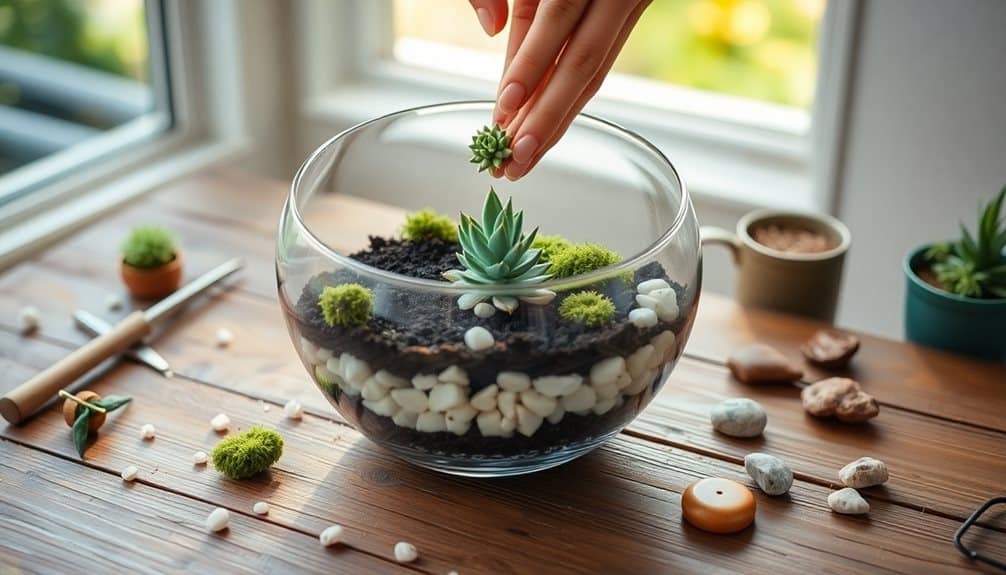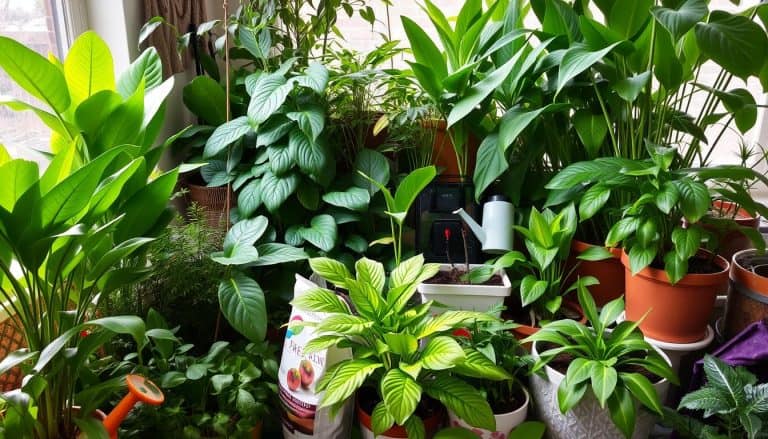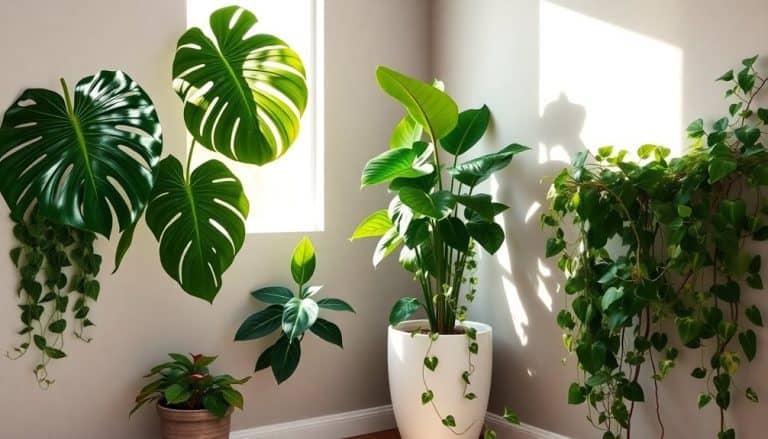This website contains affiliate links. Some products are gifted by the brand to test. As an Amazon Associate, I earn from qualifying purchases. The content on this website was created with the help of AI.
You’ll need a clean glass container, activated charcoal, gravel, potting soil, and suitable plants to create your own terrarium. Start by layering 1-inch of charcoal for filtration, followed by 2 inches of gravel for drainage, and top with well-draining potting soil mixed with perlite. Choose compatible plants like Fittonia, Peperomia, or small ferns for closed terrariums, or succulents for open designs. Position taller plants in the center, spacing them 2 inches apart, and add decorative elements like driftwood or river stones. Proper placement in indirect light and mindful watering will establish your terrarium’s self-sustaining ecosystem, but mastering the finer points guarantees long-term success.
Key Takeaways
- Choose a clean glass container with adequate depth and opening, ensuring it matches your chosen plants’ moisture requirements.
- Layer the container with 1-inch activated charcoal, 2-inch gravel, moss barrier, and well-draining potting soil mixture.
- Select compatible plants under 6 inches at maturity, ensuring they share similar light and moisture needs.
- Position taller plants in the center, space them 2 inches apart, and loosen root balls before planting.
- Maintain proper moisture levels, provide indirect light, and regularly prune dead foliage to prevent fungal growth.
What Is a Plant Terrarium
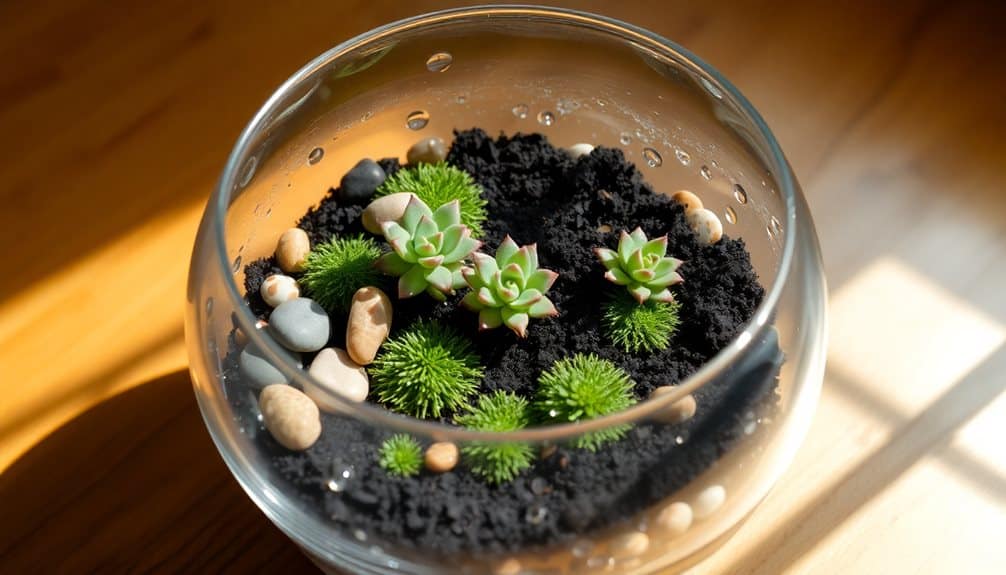
Within the domain of indoor gardening, a plant terrarium is a self-contained miniature ecosystem housed in a clear glass or plastic container. You’ll find that these enclosed environments create their own water cycle, where moisture evaporates, condenses on the container’s walls, and returns to the soil, requiring minimal maintenance once established.
A terrarium functions as a miniature greenhouse, maintaining consistent humidity levels that benefit tropical and moisture-loving plants. You’ll notice two primary types: closed terrariums, which feature a lid and excel at housing humidity-dependent species like ferns and mosses, and open terrariums, which lack a cover and better suit plants that prefer drier conditions, such as succulents and cacti.
The enclosed environment protects your plants from external factors like drafts, temperature fluctuations, and household dust. You’re fundamentally recreating a specific biome in miniature, complete with its own microclimate. The container’s transparency allows you to observe not only the plants but also the ecological processes at work, including condensation patterns, root development, and the natural decomposition of organic matter within the system. To ensure your terrarium thrives, you can find essential terrarium supplies online, from specialized containers to suitable growing media.
Essential Tools and Materials
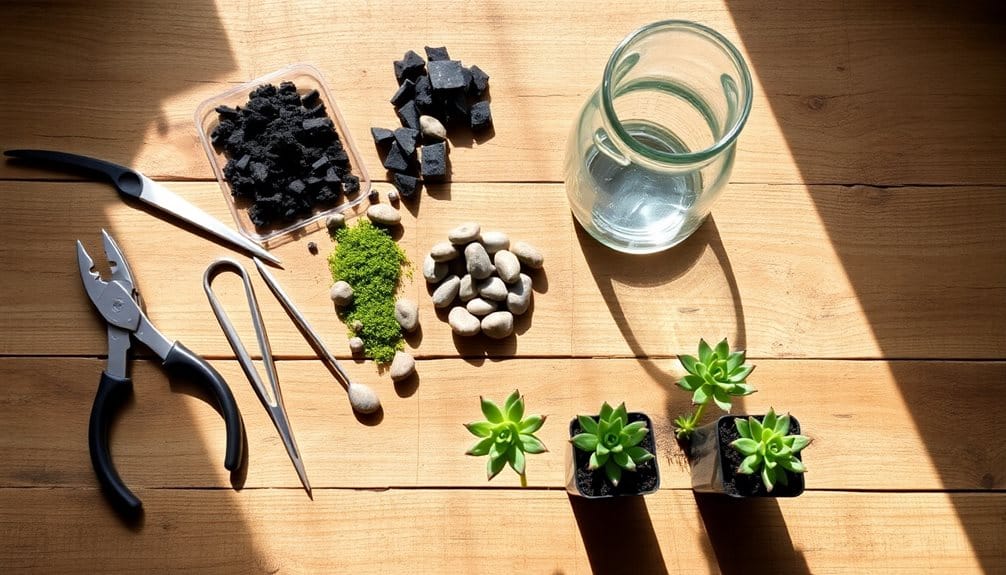
To get started with terrarium construction, you’ll need to gather several essential components and tools. The primary materials include a clear glass container with adequate depth, activated charcoal for filtration, well-draining potting soil, decorative stones or gravel, and suitable terrarium plants. You’ll also need mesh screening to separate layers and prevent soil migration.
For assembly and maintenance, you’ll require long-handled tools: a small trowel or scoop for substrate placement, long tweezers for precise plant positioning, and scissors for pruning. A spray bottle with distilled water is essential for maintaining proper humidity levels. Don’t forget cleaning supplies, including microfiber cloths for glass maintenance and a narrow brush for reaching corners.
Select appropriate planting materials based on your terrarium type. For closed terrariums, choose tropical plants that thrive in humidity, such as Fittonia, Peperomia, or miniature ferns. For open terrariums, opt for succulents or air plants that prefer drier conditions. Your substrate layers should include a 1-inch drainage layer, ½-inch activated charcoal layer, and 2-3 inches of specialized terrarium soil mix. Place plant saucers underneath your terrarium container to protect furniture surfaces and catch any excess water drainage.
Choosing the Right Container
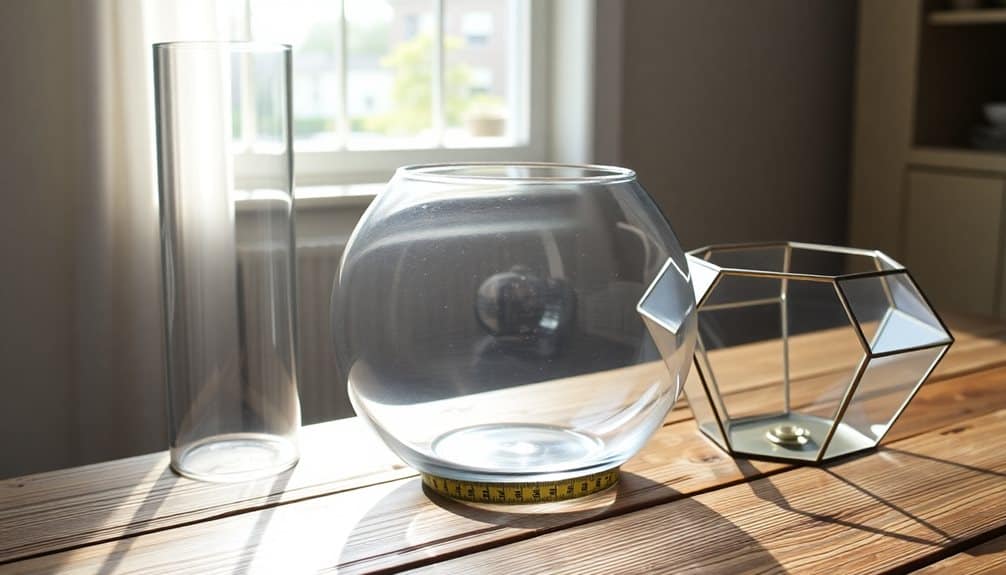
Selecting an appropriate container serves as the foundation for a successful terrarium ecosystem. The vessel must provide adequate space for plant growth while maintaining proper humidity and airflow conditions. When choosing your terrarium container, consider both the aesthetic appeal and functional requirements that align with your selected plant species.
Glass containers are ideal for terrariums as they allow light penetration and moisture retention. Choose between sealed containers for humidity-loving plants or open vessels for succulents and cacti that require better air circulation. The container’s size should accommodate your plants’ mature growth while maintaining proportional aesthetics.
- Glass containers must be transparent and free from colored or treated surfaces that could filter essential light
- Opening diameter should be wide enough (minimum 4 inches) to facilitate planting and maintenance
- Height should provide at least 6-12 inches of vertical space for plant growth and root development
- Container walls should be free from scratches or imperfections that could harbor harmful bacteria
- Drainage capacity should match your plants’ requirements – closed systems for tropical species, open systems for arid-environment plants
Consider containers with lids if you’re planning to create a sealed environment, as this allows better control over humidity levels and creates a self-sustaining microclimate. Similar to weather-resistant garden decor, your terrarium container should withstand various environmental conditions while maintaining its aesthetic appeal.
Best Plants for Terrariums
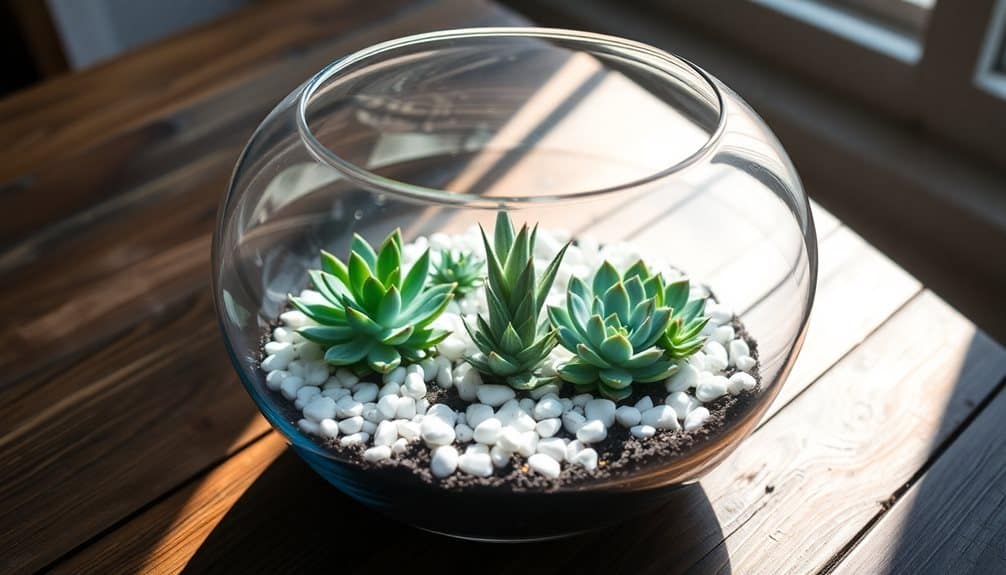
Success in terrarium gardening depends heavily on choosing plants that thrive in miniature enclosed environments. Select moisture-loving plants that won’t outgrow their container and can tolerate high humidity. Fittonia (nerve plant), Peperomia, and Selaginella are excellent choices due to their compact growth habits and affinity for humid conditions.
For closed terrariums, focus on tropical species that naturally grow in understory environments. Cryptanthus, miniature ferns like Button Fern (Pellaea rotundifolia), and Moss (Bryophyta) create stunning displays while maintaining appropriate scale. You’ll want to avoid succulents and cacti in closed systems, as they’re prone to rot in high-moisture environments.
If you’re working with an open terrarium, you can incorporate small succulents like Haworthia or Echeveria, as they’ll benefit from better air circulation. Air plants (Tillandsia) also work well in open designs. When selecting companions, make certain all chosen plants have similar light and moisture requirements. Aim for specimens that won’t exceed 6 inches in height at maturity, and space them appropriately to allow for minimal future maintenance and pruning needs. Consider adding a small indoor water fountain near your terrarium to create a harmonious meditation space that enhances humidity levels for your plants.
Preparing Your Container

A pristine container forms the foundation of any successful terrarium. Before introducing any plants or substrate, you’ll need to thoroughly clean and sterilize your chosen vessel to eliminate harmful pathogens and mineral deposits that could affect plant health. Use a solution of one part bleach to nine parts water, followed by thorough rinsing and complete air drying. Consider adding bokashi bran nutrients to your substrate layers for enhanced plant growth and microbial activity.
When selecting and preparing your container, consider these essential factors:
- Guarantee adequate drainage by adding a 1-inch layer of activated charcoal at the bottom to prevent water stagnation and root rot
- Check for airtight sealing capabilities if you’re creating a closed terrarium system for moisture-loving plants
- Inspect for sharp edges or imperfections that could damage plant tissue or create safety hazards
- Verify the container’s transparency level – clear glass is ideal for photosynthesis, while tinted glass may reduce light transmission
- Calculate the container’s volume to determine appropriate substrate depths (general rule: total substrate should occupy 1/4 of container height)
Once your container is properly prepared, you can proceed with layering your drainage materials and substrate components, guaranteeing proper depth ratios for sustainable plant growth.
Creating the Perfect Soil Layers

Proper soil layering serves as the critical foundation for a thriving terrarium ecosystem. You’ll need to create distinct layers that support proper drainage and root development while preventing soil compaction and root rot.
Start with a 1-inch base layer of activated charcoal, which acts as a natural filter and helps prevent bacterial growth. Next, add a 2-inch layer of coarse gravel or pebbles to establish effective drainage. Above this, place a thin layer of sphagnum moss or landscape fabric to prevent soil from settling into the drainage layers.
For the primary growing medium, you’ll want to combine three parts well-draining potting soil with one part perlite and one part coarse sand. This mixture provides ideal aeration and moisture retention for terrarium plants. If you’re creating a tropical terrarium, add orchid bark to increase humidity levels and improve drainage.
Layer this soil mixture 2-3 inches deep, creating small hills and valleys for visual interest and varied planting depths. Don’t compress the soil too firmly – roots need space to grow and establish themselves naturally within the substrate.
Planting and Arranging
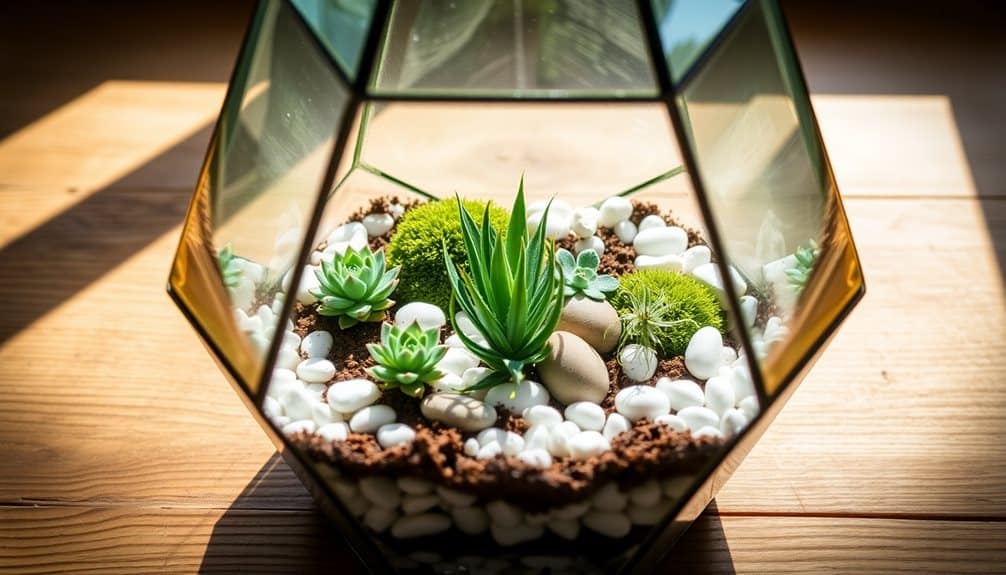
Creating visually appealing plant arrangements requires three key considerations: height variation, textural contrast, and spatial distribution. Begin planting by positioning taller specimens toward the back or center of your terrarium, creating a natural focal point. Select plants with varying leaf sizes and growth habits to establish visual interest and depth within the confined space.
When placing your plants, you’ll want to:
- Remove each plant from its nursery container and gently loosen the root ball to encourage new growth
- Create planting holes approximately 1.5 times the width of each root ball
- Position plants at their original growing depth, avoiding burial of stems or crowns
- Space plants at least 2 inches apart to allow for growth and air circulation
- Firm the soil gently around each plant to eliminate air pockets
Work methodically from largest to smallest specimens, ensuring each plant has adequate room for development. Consider the mature size of your chosen species, as most terrarium plants will establish and grow over time. After positioning all plants, use fine-tipped tweezers to remove any fallen debris and add small decorative elements like moss or miniature stones to complete the composition.
Adding Decorative Elements
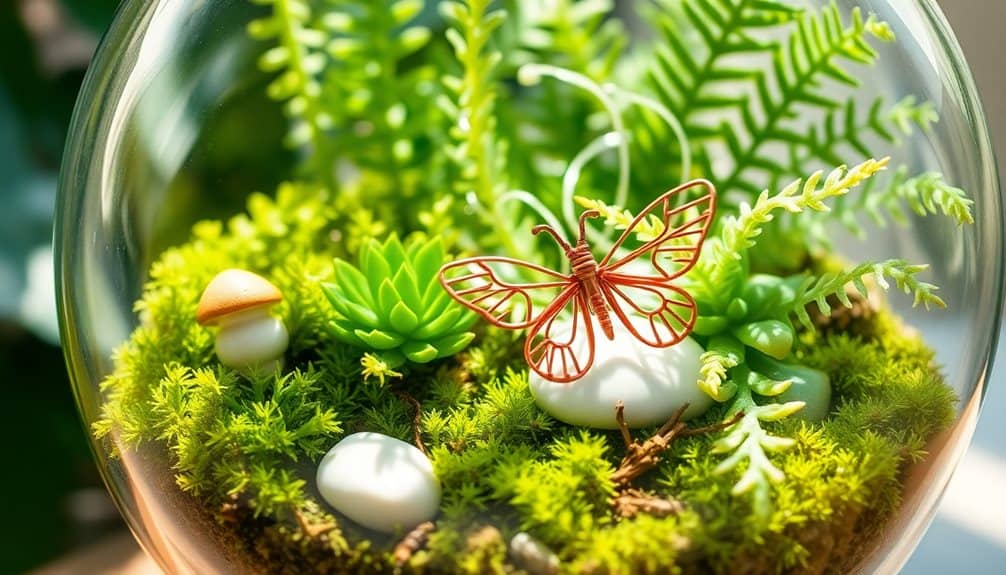
Enhance your terrarium’s visual appeal by strategically incorporating decorative elements that complement your plant composition. Select natural materials like weathered driftwood, moss-covered stones, or mineralized quartz crystals that won’t alter your terrarium’s pH balance or introduce harmful compounds. Position these elements to create focal points and establish visual harmony within your miniature ecosystem.
Consider incorporating preserved lichens, bark fragments, or small river pebbles to add textural variation and create naturalistic shifts between plant groupings. You’ll want to maintain proper spacing between decorative items to prevent moisture accumulation and potential root compression. For enclosed terrariums, avoid metallic ornaments that may oxidize in the humid environment.
Scale is essential when selecting decorative pieces – they shouldn’t overshadow your plants or impede their growth patterns. If you’re adding miniature figurines, choose non-toxic materials like ceramic or glass that won’t degrade over time. Position taller decorative elements toward the back or center, creating depth perspective while ensuring they don’t block light from reaching your plants. Remember to sanitize all decorative items in a mild bleach solution before placement to eliminate potential pathogens or pest eggs.
Basic Care and Maintenance
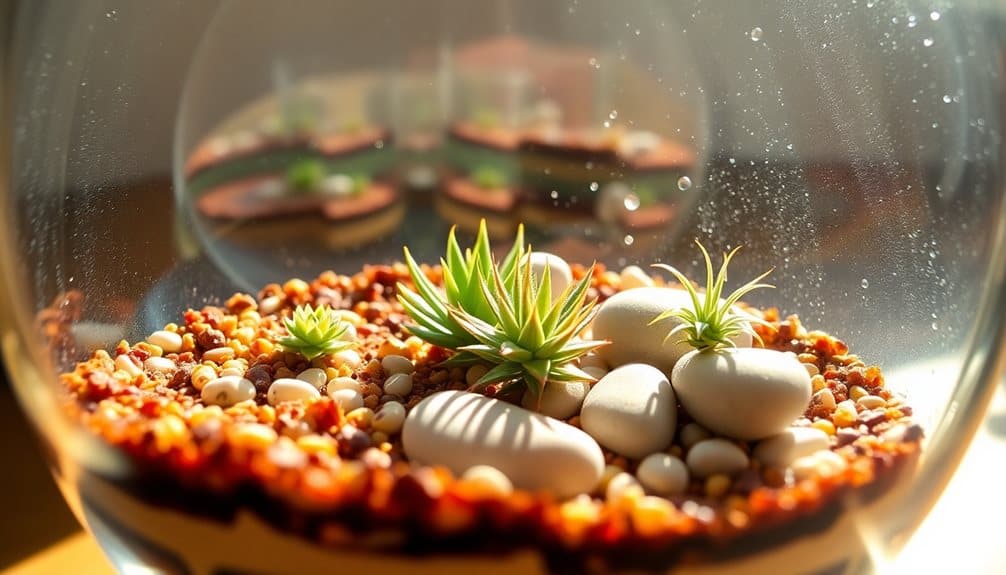
With your terrarium’s aesthetic elements in place, maintaining its health requires consistent monitoring and care routines. The enclosed environment creates a self-sustaining ecosystem, but it still needs regular attention to thrive. Monitor moisture levels by checking condensation patterns on the glass walls and inspect your plants weekly for signs of decay or disease.
Your terrarium’s longevity depends on proper maintenance practices. Prune any yellowing or dead foliage promptly to prevent fungal growth, and remove fallen leaves from the substrate surface. If you notice excessive condensation, ventilate the container briefly to prevent water stagnation and potential root rot.
- Water sparingly only when the top layer of soil feels dry, using a spray bottle or small watering can with a narrow spout
- Position your terrarium in indirect light, avoiding direct sunlight which can create harmful heat buildup
- Rotate the container quarterly to guarantee even plant growth and prevent leaning
- Clean the interior glass walls every two months using a soft cloth to maintain visibility
- Test soil pH annually and adjust the substrate composition if necessary to maintain ideal growing conditions
Troubleshooting Common Problems
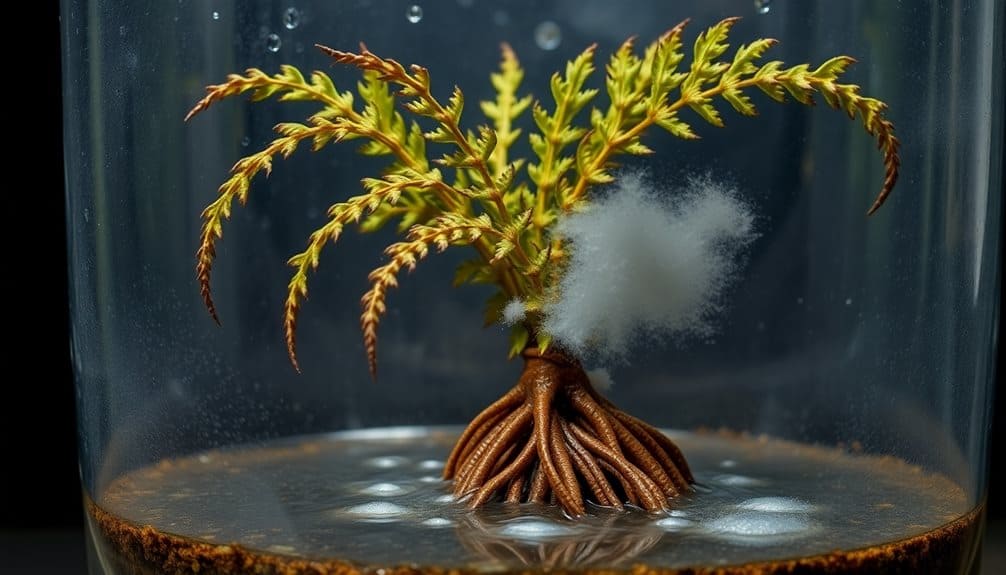
Even well-maintained terrariums can develop issues that require prompt intervention. If you notice yellowing leaves, it’s likely due to overwatering or poor drainage. Remove affected foliage and reduce watering frequency. For brown, crispy leaves, increase humidity by misting or partially closing the terrarium’s lid.
If you spot white fuzzy growth on the soil or plants, you’re dealing with mold. Improve air circulation by opening the lid, reduce watering, and remove affected areas. Fungal gnats indicate consistently wet conditions – let the top layer of soil dry between waterings and consider adding a layer of sand.
When plants become leggy or stretched, they’re receiving insufficient light. Relocate your terrarium to a brighter spot, but avoid direct sunlight that can scorch leaves. For overcrowding issues, prune plants back to maintain proper spacing. If condensation becomes excessive, leave the lid open longer to regulate humidity levels.
Root rot presents as blackened, mushy stems at soil level. Remove affected plants immediately, and verify your drainage layer is functioning properly. For pest infestations, isolate the terrarium and treat with appropriate horticultural oils or insecticidal soaps.
Frequently Asked Questions
Can I Create a Terrarium Using Artificial Plants Instead of Live Ones?
You can create an artificial plant terrarium, though it won’t provide the living ecosystem benefits of traditional terrariums. Use high-quality silk or plastic plants, ensuring they’re properly scaled for your container. Layer your substrate materials as you would for live plants: gravel, activated charcoal, and soil. Without living plants, you won’t need drainage holes or moisture management, making maintenance virtually effortless.
How Much Should I Expect to Spend on Making My First Terrarium?
Your first terrarium project can dance between $20 to $100, like a balancing act of choices. The basic essentials—a glass container ($10-30), quality potting soil ($5-10), activated charcoal ($5), and decorative stones ($5-10)—form your foundation. Live plants typically run $3-8 each, while tools and decorative elements add another $10-20. You’ll find budget-friendly options at craft stores and garden centers.
Are Terrariums Safe to Keep Around Pets and Small Children?
While terrariums can pose risks, you’ll need to carefully consider their placement and contents. Glass containers present breakage hazards, and some common terrarium plants like philodendrons and pothos are toxic if ingested. You’ll want to position your terrarium out of reach and select pet-safe plants like spider plants, African violets, or baby tears. Be mindful that small decorative elements could become choking hazards if accessed.
Can I Use My Terrarium as a Centerpiece for Outdoor Garden Parties?
You’ll find terrariums make stunning outdoor centerpieces, but you’ll need to take precautions. While they’re naturally eye-catching, direct sunlight can create a greenhouse effect that may harm your plants and potentially crack the glass. Place your terrarium in a shaded area during parties, and consider using LED lights or battery-operated votives around it for ambiance. Don’t leave it outdoors overnight, as temperature fluctuations can damage the microclimate inside.
Is It Possible to Propagate Plants From My Existing Terrarium?
You can propagate many terrarium plants through various methods, including stem cuttings, leaf cuttings, and division. For best success, select healthy parent plants and use sterilized tools. Most tropical species like Peperomia, Fittonia, and Pilea propagate readily in moist conditions. Simply snip a healthy stem or leaf, remove lower leaves, and place the cutting in the terrarium’s substrate. Most cuttings will root within 2-4 weeks.

